
The Legislative Duma of Tomsk Oblast
Tomsk Oblast: history and modern times. Tomsk Oblast 70 years old. Tomsk Governorate 210 years old. Tomsk 410 years old
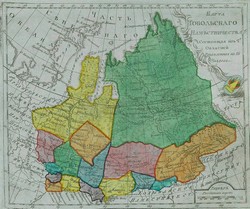 Tomsk Oblast first came into existence in 1782 and lasted for 16 years. Together with Tobolsk Oblast it was part of Tobolsk Vicegerency. It consisted of six districts – Tomsky, Achinsky, Yeniseisky, Turukhansky, Narymsky, and Kainsky. Tomsk was its administrative center. In 1798, the vicegerency system was abolished and Tobolsk Vicegerency became Tobolsk Governorate. In 1804, Tomsk Governorate became an independent administrative unit of the Russian Empire. As a governorate, it existed for 120 years until 1925.
Tomsk Oblast first came into existence in 1782 and lasted for 16 years. Together with Tobolsk Oblast it was part of Tobolsk Vicegerency. It consisted of six districts – Tomsky, Achinsky, Yeniseisky, Turukhansky, Narymsky, and Kainsky. Tomsk was its administrative center. In 1798, the vicegerency system was abolished and Tobolsk Vicegerency became Tobolsk Governorate. In 1804, Tomsk Governorate became an independent administrative unit of the Russian Empire. As a governorate, it existed for 120 years until 1925.
Tomsk Oblast as it exists today was established on August 13, 1944 under a decree by the Presidium of the Supreme Soviet of the USSR. It comprised 19 districts of Novosibirsk Oblast and Zyransky District of Kemerovo Oblast. On October 7, 1944 a conciliation committee made up of representatives of Novosibirsk and Tomsk Oblasts signed an agreement on a territorial and economic separation of the two regions.
Currently, Tomsk Oblast consists of sixteen municipal districts – Aleksandrovsky, Asinovsky (Asino, 1973), Bakcharsky, Verkhneketsky, Zyryansky, Kargasoksky, Kozhevnikovsky, Kolpashevsky (Kolpashevo, 1938), Krivosheinsky, Molchanovsky, Parabelsky, Pervomaysky, Teguldetsky, Tomsky, Chainsky, Shegarsky; four city districts – Tomsk (1604), Kedrovy (1988), Strezhevoy (1978), Seversk (closed administrative and territorial formation in 1944, closed city in 1954).
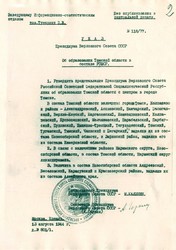 Changes in the administrative and territorial division passed unnoticed in the beginning. However, when the status of Tomsk as a regional capital allowed to significantly increase spending in the social and economic sectors, the citizens of Tomsk Oblast finally appreciated stepping out of the shade of Novosibirsk.
Changes in the administrative and territorial division passed unnoticed in the beginning. However, when the status of Tomsk as a regional capital allowed to significantly increase spending in the social and economic sectors, the citizens of Tomsk Oblast finally appreciated stepping out of the shade of Novosibirsk.
Population
Tomsk Oblast is one of 24 regions of Russia with natural population growth for 7 years in a row. Tomsk Oblast population growth trend – 395,000 people in 1926; 642,500 people in 1939; 746,800 people in 1959; 785,700 people in 1970; 865,900 people in 1979; 1,001,600 people in 1989; 1,046,000 people in 2002; 1,070,000 people in 2014.
More than a hundred nationalities live in Tomsk Oblast, among them Russians 92%, Tatars 1.7%, Ukrainians 1.1%, Germans 0.9%, Azerbaijanis, Chuvashs, and Uzbekistanis 0.4% each. Indigenous people include along with Tatars, Selkups – 1,180 people, Khanty – 718 people, and Chulyms – 200 people. The region has a low average population density of 3.4 per sq km. Population distribution is highly uneven with 80% of people living in eight administrative districts in the south and south-east which account for 15% of the region’s territory. In these areas the population density is 7-8 people per sq km. 65% of all people live in Tomsk District which includes the cities of Tomsk and Seversk. In the remaining territory of the region the population density is 0.3-0.5 people per sq km. 70% of the population live in urban areas, 30% in rural areas. Tomsk Oblast has 6 cities – Tomsk (558,000 people), Seversk (109,000 people), Strezhevoy (41,300 people), Asino (24,500 people), Kolpashevo (23,000 people), and Kedrovy (2,500 people).
Government
 The government system of the region is defined by the Charter of Tomsk Oblast. The Legislative Duma of Tomsk Oblast is the legislative branch. The Governor and the Tomsk Oblast Administration are the executive branch. The flag and the coat of arms of Tomsk Oblast were adopted by the Tomsk Oblast Duma on May 25, 1997. The coat of arms of Tomsk Oblast preserved since 1804, as well as the coat of arms of Tomsk depict a white horse galloping to the right in a green modern French shield twined with oak leaves and a green and white ribbon and crowned with a king’s crown. The flag depicts the coats of arms in the middle of white background.
The government system of the region is defined by the Charter of Tomsk Oblast. The Legislative Duma of Tomsk Oblast is the legislative branch. The Governor and the Tomsk Oblast Administration are the executive branch. The flag and the coat of arms of Tomsk Oblast were adopted by the Tomsk Oblast Duma on May 25, 1997. The coat of arms of Tomsk Oblast preserved since 1804, as well as the coat of arms of Tomsk depict a white horse galloping to the right in a green modern French shield twined with oak leaves and a green and white ribbon and crowned with a king’s crown. The flag depicts the coats of arms in the middle of white background.
Geography and climate
Tomsk Oblast has an area of 314,000 sq km. It is the 16th largest region of Russia for its area and the 49th for its population.
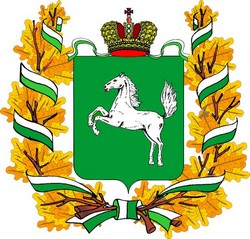 The land is mainly flat swamps with highest elevations at 200 meters above sea level. The highest point is 258 meters above sea level. It is situated in the south-east where the spurs of Kuznetsk Alatau Mountain Range enter the region. The Ob River flows from southeast to northwest and divides Tomsk Oblast into two almost equal parts. The right bank is slightly elevated (up to 193 m) versus the left bank (up to 166 m). On the left side lies the world’s largest swamp Vasyugan (53,000 sq km). The Ob River has a wide valley which occupies the central part of the region. The flatlands sloping to the river are named after its tributaries – Chylym, Ket-Tym, Vasyugan, Ob-Tym. Swamps cover 40% and river valleys cover 20% of the region’s territory. The Ob River and its main tributaries Tom, Chulym, Ket, Tym, Vasyugan, Chaya, Parabel, Shegarka drain the soils which consist of unconsolidated sedimentary rock. Bogging and paludification are the predominant relief-shaping processes driven by the economic activity of the population.
The land is mainly flat swamps with highest elevations at 200 meters above sea level. The highest point is 258 meters above sea level. It is situated in the south-east where the spurs of Kuznetsk Alatau Mountain Range enter the region. The Ob River flows from southeast to northwest and divides Tomsk Oblast into two almost equal parts. The right bank is slightly elevated (up to 193 m) versus the left bank (up to 166 m). On the left side lies the world’s largest swamp Vasyugan (53,000 sq km). The Ob River has a wide valley which occupies the central part of the region. The flatlands sloping to the river are named after its tributaries – Chylym, Ket-Tym, Vasyugan, Ob-Tym. Swamps cover 40% and river valleys cover 20% of the region’s territory. The Ob River and its main tributaries Tom, Chulym, Ket, Tym, Vasyugan, Chaya, Parabel, Shegarka drain the soils which consist of unconsolidated sedimentary rock. Bogging and paludification are the predominant relief-shaping processes driven by the economic activity of the population.
There are 573 rivers more than 20 km long. Their total length is 39,500 km. They all belong to the basin of the Middle Ob. The part of the Ob which flows across the region is 1,065 km long. The region’s longest rivers are Chulym (1,799 km), Ket (1,621 km), Vasyugan (1,082 km), Tym (950 km), Tom (827 km), Parabel (308 km). Chulym and Tom Rivers rise in the Kuznetsk Alatau Mountains. Other rivers rise from watershed moors on the borders of Novosibirsk and Omsk Oblasts and Krasnoyarsk Krai. There are 18,100 rivers in total with total length 95,000 km. There are many large and small rivers flowing across taiga. They are mostly slow and twisty rivers with wide floodplains. There are many floodplain and wetland lakes (12,900 lakes with total area 4,451 sq km). Southern lands are rich in ponds (29 ponds and water reservoirs with total capacity 30 million cu m). Watersheds are waterlogged with predominant raised oligotrophic acid bogs. Floods occur in springtime when snow melts. Water rises at least 5 meters above the low water mark in the Chulym and up to 9 meters in the Ob. Floodplains stay full for 20-30 days in small rivers and up to 2 months in large rivers. River Tom often has ice jams with water rising 8-11 meters. Rainfall floods typically occur in August and September.
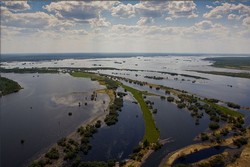 The region’s location in middle latitudes (between 61° North and 55° North) on a flat plain exposed to winds from north and south predetermines highly variable climatic conditions with huge temperature swings throughout the year and during the day. Humidity depends on west Atlantic cyclones. The north of the region is influenced by Arctic Lows, the south by Asian Highs. East Siberian Highs predetermine the climate across the entire region. Winter is long beginning October 23-29 in the north and November 5-8 in the south. It ends late in March or early in April. The weather is cold and sunny 30% of the time. The sun is low. Average temperatures in January are 19-23°C below zero with minimum temperatures dropping as low as 50-58°C below zero. The snow blanket is the thickest in March. The snow water equivalent ranges from 100 mm in the south to 200 mm in the north-east. The spring is short and windy. Average temperatures rise by 17-19°C. The snow fully melts late in April or early in May. The summer begins late in May or early in June and ends early in September. In the south it is 19 days longer. The sun is high and hot. The day lasts 16-19 hours. The average temperatures in July are 22-24°C with maximum temperatures 36-38°C. The daily range of temperature is 12-15°C, which causes freezing in June and August and makes farming very difficult. Autumn begins early in September and ends late in October. The weather is unstable. Surges of air from the north and south sometimes bring along short Indian summers and sometimes snow. The region’s average annual temperature is 3°C below zero in the north-east and 0.6°C below zero in the south. Thunderstorms are common in July, fogs in August, snowstorms in winter, frosts from October through May. Mean annual precipitation is 400-570 mm with peaks in July and August when rainfalls commonly occur.
The region’s location in middle latitudes (between 61° North and 55° North) on a flat plain exposed to winds from north and south predetermines highly variable climatic conditions with huge temperature swings throughout the year and during the day. Humidity depends on west Atlantic cyclones. The north of the region is influenced by Arctic Lows, the south by Asian Highs. East Siberian Highs predetermine the climate across the entire region. Winter is long beginning October 23-29 in the north and November 5-8 in the south. It ends late in March or early in April. The weather is cold and sunny 30% of the time. The sun is low. Average temperatures in January are 19-23°C below zero with minimum temperatures dropping as low as 50-58°C below zero. The snow blanket is the thickest in March. The snow water equivalent ranges from 100 mm in the south to 200 mm in the north-east. The spring is short and windy. Average temperatures rise by 17-19°C. The snow fully melts late in April or early in May. The summer begins late in May or early in June and ends early in September. In the south it is 19 days longer. The sun is high and hot. The day lasts 16-19 hours. The average temperatures in July are 22-24°C with maximum temperatures 36-38°C. The daily range of temperature is 12-15°C, which causes freezing in June and August and makes farming very difficult. Autumn begins early in September and ends late in October. The weather is unstable. Surges of air from the north and south sometimes bring along short Indian summers and sometimes snow. The region’s average annual temperature is 3°C below zero in the north-east and 0.6°C below zero in the south. Thunderstorms are common in July, fogs in August, snowstorms in winter, frosts from October through May. Mean annual precipitation is 400-570 mm with peaks in July and August when rainfalls commonly occur.
Natural resources
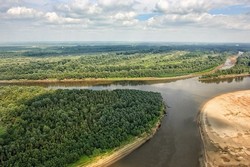 For a long time, forests were considered the primary natural resource of the region. Forests cover 28.6 million hectares or 58% of the region’s territory. The forested land spans from forest steppes in the north to birch and aspen sub-taiga woods and taiga forests in the south. The left bank of the Ob and its right bank to the north from River Ket belong to middle taiga. Softwoods (Scots pine, spruce, fir, larch and Siberian pine) account for 58% of all forests. Dark coniferous species such as spruce, fir and Siberian pine occupy high river terraces and well-drained elevated interfluves. Scots pine grows everywhere and dominates in the basins of the Ket and the Tym. Primary birch forests do not grow beyond 57° North. Secondary birch and aspen forests are intermingled with dark coniferous species. Floodplains are typically covered with sedge meadows and birch, aspen, willow and poplar groves. Undergrowth is dense with predominant bird cherry, elder, viburnum, mountain ash, honeysuckle, and bog willow. Wetlands are covered with Scots pine, dwarf birch, and wild rosemary.
For a long time, forests were considered the primary natural resource of the region. Forests cover 28.6 million hectares or 58% of the region’s territory. The forested land spans from forest steppes in the north to birch and aspen sub-taiga woods and taiga forests in the south. The left bank of the Ob and its right bank to the north from River Ket belong to middle taiga. Softwoods (Scots pine, spruce, fir, larch and Siberian pine) account for 58% of all forests. Dark coniferous species such as spruce, fir and Siberian pine occupy high river terraces and well-drained elevated interfluves. Scots pine grows everywhere and dominates in the basins of the Ket and the Tym. Primary birch forests do not grow beyond 57° North. Secondary birch and aspen forests are intermingled with dark coniferous species. Floodplains are typically covered with sedge meadows and birch, aspen, willow and poplar groves. Undergrowth is dense with predominant bird cherry, elder, viburnum, mountain ash, honeysuckle, and bog willow. Wetlands are covered with Scots pine, dwarf birch, and wild rosemary.
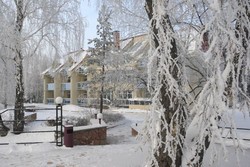 The region’s allowable cut is 26.9 million cu m. The annual height increment is 27.7 million cu m. Commercial forest reserves are estimated at 2.8 billion cu m. Annual harvesting rates do not exceed 1.7 million cu m. Forests and swamps are rich in economically valuable plants and berries such as lingonberry, whortleberry, cranberry, blueberry, blackcurrant, raspberry, cloudberry, strawberry, medicinal herbs, wild garlic, horseradish, hop, sorrel, mushrooms. There are 24 particularly valuable Siberian pine nut harvesting areas with a total area 394,800 hectares.
The region’s allowable cut is 26.9 million cu m. The annual height increment is 27.7 million cu m. Commercial forest reserves are estimated at 2.8 billion cu m. Annual harvesting rates do not exceed 1.7 million cu m. Forests and swamps are rich in economically valuable plants and berries such as lingonberry, whortleberry, cranberry, blueberry, blackcurrant, raspberry, cloudberry, strawberry, medicinal herbs, wild garlic, horseradish, hop, sorrel, mushrooms. There are 24 particularly valuable Siberian pine nut harvesting areas with a total area 394,800 hectares.
Wildlife
 Tomsk Oblast is rich in wildlife – 347 species of vertebrates inhabit its territory, including 15 species of predators, 3 species of even-toed hoofed mammals, 28 species of rodents, 247 species of birds, 3 species of reptiles, 6 species of amphibians, 34 species of fish. There are some 3,500 species of invertebrates. In taiga regions, common species are squirrel, chipmunk, sable, brown bear, elk, lynx, wood grouse, hazel grouse, bullfinch, nutcracker, nuthatch. Forest steppes are home for mole, polecat, fox, wolf, roe deer, hamster, partridge, lark. Sparrows, crows, frogs, toads, and ants are spread across the entire territory of the region. Bloodsucking insects – 32 species of gnats, 8 species of black fly, 5 species of biting midges, 32 species of horse-fly – torment people and animals in the summer. Ixodid ticks carry encephalitis and many other diseases. There are 28 commercial species of animals, more than 30 commercial species of birds and 19 species of economically valuable fish. The average fish harvest has shrank almost 4 times since the end of World War II – from 6,860 to 1,780 tons per year. Fish populations were significantly reduced when the Novosibirsk hydro power dam was built in 1957. The dam blocked the ways to spawning sites of sturgeon, sterlet, and nelma, and caused fish die-off from Kolpashevo to the mouth of the Vasyugan.
Tomsk Oblast is rich in wildlife – 347 species of vertebrates inhabit its territory, including 15 species of predators, 3 species of even-toed hoofed mammals, 28 species of rodents, 247 species of birds, 3 species of reptiles, 6 species of amphibians, 34 species of fish. There are some 3,500 species of invertebrates. In taiga regions, common species are squirrel, chipmunk, sable, brown bear, elk, lynx, wood grouse, hazel grouse, bullfinch, nutcracker, nuthatch. Forest steppes are home for mole, polecat, fox, wolf, roe deer, hamster, partridge, lark. Sparrows, crows, frogs, toads, and ants are spread across the entire territory of the region. Bloodsucking insects – 32 species of gnats, 8 species of black fly, 5 species of biting midges, 32 species of horse-fly – torment people and animals in the summer. Ixodid ticks carry encephalitis and many other diseases. There are 28 commercial species of animals, more than 30 commercial species of birds and 19 species of economically valuable fish. The average fish harvest has shrank almost 4 times since the end of World War II – from 6,860 to 1,780 tons per year. Fish populations were significantly reduced when the Novosibirsk hydro power dam was built in 1957. The dam blocked the ways to spawning sites of sturgeon, sterlet, and nelma, and caused fish die-off from Kolpashevo to the mouth of the Vasyugan.
Beaver was exterminated by the end of the 18th century. Sable, stoat, Siberian weasel, elk almost disappeared at the turn of the 19th century. Today, the populations of elk, sable, and beaver have been restored. New species were brought into the region such as American mink, muskrat, Russian desman. Wildlife in Tomsk Oblast has always been used extensively. Fur hunting and trapping volumes decreased dramatically from early 1980s to 2000s: sable from 8,000 to 2,000 pelts; squirrel from 140,000 to 12,000 pelts; muskrat from 33,000 to 5,000 pelts; mink from 4,000 to 600 pelts. For the preservation of wildlife a number of protection areas were set up, including 15 faunal areas, 3 protected landscape areas, 1 botanical garden, and 145 regionally important natural monuments.
Oil, gas and mineral resources
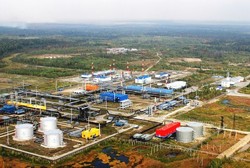 Over the last 60 years a lot of effort has been put into the geological exploration of subsoil in Tomsk Oblast. In the first half of the 20th century, Tuganskoye silica sands was the only known mineral deposit. In 1948, drilling of deep wells and geophysical studies of subsoil were started. Oil was first found in 1953 near Kolpashevo. In 1966, commercial oil was first produced in Sovetskoye field. At present, 131 petroleum deposits are known, including 103 oil fields, 20 oil and condensate fields, and 8 gas and condensate fields. As of late, all newly discovered fields are small. The total oil and gas prospect area is 224,000 sq km or 70% of the region’s territory. Only the area of 73,000 sq km is being developed meaning that 75% of the oil and gas reserves is yet to be discovered. Over the years of intense oil and gas production, 330 million tons of oil has been produced, or 20% of all extractable resources. Tomsk Oblast is one of the regions in the Siberian Federal District with the highest oil and gas production output. Over the last several years, oil production rates are decreasing throughout the region. That makes the regional oil and gas producers focus more on ways to develop hard-to-recover reserves.
Over the last 60 years a lot of effort has been put into the geological exploration of subsoil in Tomsk Oblast. In the first half of the 20th century, Tuganskoye silica sands was the only known mineral deposit. In 1948, drilling of deep wells and geophysical studies of subsoil were started. Oil was first found in 1953 near Kolpashevo. In 1966, commercial oil was first produced in Sovetskoye field. At present, 131 petroleum deposits are known, including 103 oil fields, 20 oil and condensate fields, and 8 gas and condensate fields. As of late, all newly discovered fields are small. The total oil and gas prospect area is 224,000 sq km or 70% of the region’s territory. Only the area of 73,000 sq km is being developed meaning that 75% of the oil and gas reserves is yet to be discovered. Over the years of intense oil and gas production, 330 million tons of oil has been produced, or 20% of all extractable resources. Tomsk Oblast is one of the regions in the Siberian Federal District with the highest oil and gas production output. Over the last several years, oil production rates are decreasing throughout the region. That makes the regional oil and gas producers focus more on ways to develop hard-to-recover reserves.
Tomsk Oblast has deposits of various ore minerals such as iron ore, zircon and ilmenite sands, gold and platinum deposits, zinc ores, and bauxites. The world’s largest iron ore deposit – the West Siberian iron ore basin – is located in Tomsk Oblast. Its estimated total potential iron ore reserves are 393 billion tons (more than 30%). Tuganskaya and Georgiyevskaya zircon and titanium deposits (124.7 million cu m and 3 billion cu m respectively) contain up to 30% of Russia’s titanium dioxide reserves. Tugan sands also contain vanadium, scandium, tantalum, hafnium, and other rare-earth elements. The tributaries of River Tom carry gold. Near Turuntayevo village, at the depth of 500 meters there is a unique zinc deposit containing at least 500,000 tons of zinc ore. Tomsk Oblast shares with Kemerovo Oblast a large bauxite deposit known as Barzas with estimated bauxite reserves of 11.5 million tons.
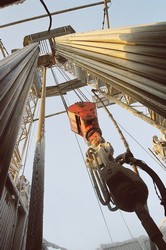 There are some 100 brown coal occurrences and deposits. They are grouped into 7 larger coal regions – Tomsky, Dolinny, Chulymsky, Bakcharo-Chainsky, Parabelsky, Vasyugan-Tymsky, Aleksandrovsky. So far, only Talovskoye deposit in Tomsky coal area has potential for commercial development with an average coal seam thickness of 4 meters. Its estimated reserves are 3.6 billion tons. Coal is used for the production of electricity and as a raw material for the chemical industry. There are 98 known deposits of construction materials, clay, and kaolin. Out of them 30 are being commercially developed. River Tom’s bed is rich in sand and gravel – it is the largest sand and gravel deposit in Western Siberia. There are large reserves of high-quality silica sand and limestone. Tomsk Oblast is rich in peat. There are 1,505 deposits with total peat reserves of 29.3 billion tons – the second largest in the world after those of Tyumen Oblast. Many lakes in Tomsk Oblast (70%) contain sapropel deposits which have not been estimated yet.
There are some 100 brown coal occurrences and deposits. They are grouped into 7 larger coal regions – Tomsky, Dolinny, Chulymsky, Bakcharo-Chainsky, Parabelsky, Vasyugan-Tymsky, Aleksandrovsky. So far, only Talovskoye deposit in Tomsky coal area has potential for commercial development with an average coal seam thickness of 4 meters. Its estimated reserves are 3.6 billion tons. Coal is used for the production of electricity and as a raw material for the chemical industry. There are 98 known deposits of construction materials, clay, and kaolin. Out of them 30 are being commercially developed. River Tom’s bed is rich in sand and gravel – it is the largest sand and gravel deposit in Western Siberia. There are large reserves of high-quality silica sand and limestone. Tomsk Oblast is rich in peat. There are 1,505 deposits with total peat reserves of 29.3 billion tons – the second largest in the world after those of Tyumen Oblast. Many lakes in Tomsk Oblast (70%) contain sapropel deposits which have not been estimated yet.
Tomsk Oblast lies within the vast West Siberian Artesian Basin. It has large reserves of underground water used for household, farming, and industrial purposes. The region’s fresh underground water production volumes total 142 million cu m per year (1% of estimated predicted reserves). Tomsk, Strezhevoy, and main cities of districts are supplied with tap water from underground sources. Tomsk Oblast has unlimited reserves of thermal, mineral, and commercial water. There are commercial drinking water wells in Teguldetsky District (Omega brand) and in Chazhemto village (Chazhemto brand).
History. Ancient times
 The territory of today’s Tomsk Oblast was colonized a very long time ago. First hunters for mammoth, bison, and rhinoceros apparently came to the region 17,000 years ago following the retreating glaciers as evidenced by Tomskaya and Mogochinskaya Paleolithic camps. When 10,000 years ago the territory got clear of glaciers, the modern river system and climate developed. First people of Tomsk Oblast were Mongoloid and Caucasian tribes. In Neolithic times, 4,000-3,000 BC people colonized the entire territory of today’s Tomsk Oblast.
The territory of today’s Tomsk Oblast was colonized a very long time ago. First hunters for mammoth, bison, and rhinoceros apparently came to the region 17,000 years ago following the retreating glaciers as evidenced by Tomskaya and Mogochinskaya Paleolithic camps. When 10,000 years ago the territory got clear of glaciers, the modern river system and climate developed. First people of Tomsk Oblast were Mongoloid and Caucasian tribes. In Neolithic times, 4,000-3,000 BC people colonized the entire territory of today’s Tomsk Oblast.
In the early 2nd millennium BC, the Samus Bronze Age culture developed in the south of the region. This culture had highly advanced metal processing skills and is believed to be ancestors of today’s Kets. In 1,500-1,000 BC, first Caucasian tribes of shepherds and farmers came to the banks of the River Ob. This culture was named Andronovo after the village near which the remains of their settlements were found (not far from Achinsk). They intermingled with hunters and fishermen in late 2nd – early 1st millennium BC and formed the Yelovskaya culture (named after village Yelovka, Kozhevnikovsky District). In 800-700 BC, the natural conditions changed. Steppes along the rivers Ket, Chulym, Vasygan, and Tym were displaced by taiga forests and swamps. Along with this change came hunters and fishermen, the ancestors of today’s Khantys. New living conditions required new skills. During the Iron Age, the so-called Shelomok culture of shepherds and farmers developed in forest steppes (named after river Tom’s Shelomok Cape) and the Kulai culture of hunters, fishermen, and horse-breeders developed in taiga (named after Kulaika Mountain in Chainsky District). Those two cultures evolved into the Upper Ob culture (5th-10th centuries AD) and the Relka culture (Relka area in Molchanovsky District – 6th-8th centuries AD). They are believed to be the ancestors of today’s Selkups. That was the time when Tomsk Oblast fell under the influence of first Turk states. In early 2nd millennium AD, the Turks forced to the north, exterminated or assimilated the Samodi and Kets. In 1,000-1,500 AD, predominant ethnic groups developed such as Tomsk Tatars, Chulyms, Khantys, and Selkups. They fought internecine wars and suffered from raids by Kyrgyz, Teleut, and Kalmyk nomad tribes.
History. 17th-19th centuries
 First Russian people came to Tomsk Oblast from the north after sable fur and fur tribute from indigenous people. In 1598, Surgut military governor Tugarin Fyodorov founded the Narym fortress in the center of the Selkups’ Skewbald Horde. It was followed by the Ket fortress in 1602. Finally, on September 27 (October 7), 1604 a military squad led by commanders Gavrila Pisemky and Vasily Tyrkov laid the foundation stones of the Tomsk fortress upon a request by a local knyaz Toyan. The new fortress was built in the lands of Tomsk Tatar tribes. In the 17th century, Tomsk was the southernmost outpost of Russin expansion in Siberia. It withstood multiple sieges by nomad tribes of Teleut, Kyrgyz, and Kalmyk. The last siege took place in 1700. Tomsk military and government service people built many fortresses and outposts such as the Urtam, Umreva, Yenisei, Achinsk, Kuznetsk, Krasnoyarsk, Bikatun, Kuzdeyevo, and others. In 1637, a cossack from Tomsk Ivan Moskvitin was the first Russian who reached the Sea of Okhotsk.
First Russian people came to Tomsk Oblast from the north after sable fur and fur tribute from indigenous people. In 1598, Surgut military governor Tugarin Fyodorov founded the Narym fortress in the center of the Selkups’ Skewbald Horde. It was followed by the Ket fortress in 1602. Finally, on September 27 (October 7), 1604 a military squad led by commanders Gavrila Pisemky and Vasily Tyrkov laid the foundation stones of the Tomsk fortress upon a request by a local knyaz Toyan. The new fortress was built in the lands of Tomsk Tatar tribes. In the 17th century, Tomsk was the southernmost outpost of Russin expansion in Siberia. It withstood multiple sieges by nomad tribes of Teleut, Kyrgyz, and Kalmyk. The last siege took place in 1700. Tomsk military and government service people built many fortresses and outposts such as the Urtam, Umreva, Yenisei, Achinsk, Kuznetsk, Krasnoyarsk, Bikatun, Kuzdeyevo, and others. In 1637, a cossack from Tomsk Ivan Moskvitin was the first Russian who reached the Sea of Okhotsk.
In the middle of the 18th century, when the Chinese defeated the nomadic Jungar tribes, and the Kygryz tribes left Minusinsk steppes, Tomsk became the administrative center of Middle Siberia. By that time, Narym and Ketsk had lost their military and administrative importance. Ketsk District became part of the Narym District in 1765, and in 1822, the underpopulated Narym District joined Tomsk District. The territories of Narym, Ketsk, and Tomsk Districts were part of a larger Tobolsk Region. In 1629, they were detached to form Tomsk Region. Under the governorate reform of 1708-1712, those districts were made part of Siberian Governorate with the capital in Tobolsk. Tomsk governor had authority over the governors of Narym, Ketsk, and Kuznetsk Districts. In 1717-1727, under the provincial reform those districts became part of Tobolsk Province. In 1764, Siberian Governorate was renamed as Siberian Kingdom, and the three districts became part of Tobolsk Governorate.
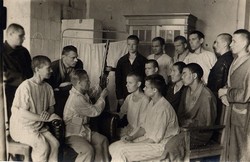 Under the governorate reform of 1779, Tomsk District was given to Kolyvan Oblast. In 1782, Tobolsk Vicegerency was created. It was divided into Tobolsk and Tomsk Oblasts, the latter composed of Tomsk, Achinsk, Yeniseisk, Turukhansk, Narym, and Kainsk Districts. In 1797, Pavel I abolished vicegerencies, and the territory of Tomsk Oblast was returned to Tobolsk Governorate. In 1803, it became part of Siberian Governorate General with the capital in Irkutsk. In 1804, Tomsk Governorate was established as a full administrative unit on the lands of the former Kolyvan Vicegerency. In 1822, under the Siberian Decree by Mikhail Speransky, Achinsk, Yeniseisk, Turukhansk, and Krasnoyarsk Districts were given to the newly established Yeniseisk Governorate. Narym District was merged with Tomsk District. In 1856, a new Mariinsk District was made up of several eastern regions (today’s Zyryansky, Teguldetsky, and Verkheketsky Districts) of Tomsk District. Up until 1861, Tomsk governors served as administrators of the Altai Mountains Okrug governed by the Tsar Cabinet.
Under the governorate reform of 1779, Tomsk District was given to Kolyvan Oblast. In 1782, Tobolsk Vicegerency was created. It was divided into Tobolsk and Tomsk Oblasts, the latter composed of Tomsk, Achinsk, Yeniseisk, Turukhansk, Narym, and Kainsk Districts. In 1797, Pavel I abolished vicegerencies, and the territory of Tomsk Oblast was returned to Tobolsk Governorate. In 1803, it became part of Siberian Governorate General with the capital in Irkutsk. In 1804, Tomsk Governorate was established as a full administrative unit on the lands of the former Kolyvan Vicegerency. In 1822, under the Siberian Decree by Mikhail Speransky, Achinsk, Yeniseisk, Turukhansk, and Krasnoyarsk Districts were given to the newly established Yeniseisk Governorate. Narym District was merged with Tomsk District. In 1856, a new Mariinsk District was made up of several eastern regions (today’s Zyryansky, Teguldetsky, and Verkheketsky Districts) of Tomsk District. Up until 1861, Tomsk governors served as administrators of the Altai Mountains Okrug governed by the Tsar Cabinet.
From December 23, 1919 till March 14, 1920 Tomsk was a district capital. In 1920-1925, it again became the capital of a governorate. Under the 1925 reform, the territory of Tomsk Oblast was divided between two okrugs of Siberian Krai – Tomsk and Mariinsk. Tomsk Okrug also included Aleksandrovsky District of Omsk Oblast. In 1928, it span off Laryak Ethnic Region and in 1937, Nizhnevartovsk and Vampugolsk Rural Council. Those three regions were returned to Ostyako-Vogulsk Okrug of Omsk Oblast. When the okrug system was abolished in 1930, the territories of Tomsk and Mariinsk Okrugs were divided into districts of West Siberian Krai and in 1937 they became part of Novosibirsk Oblast. Northern (Narym) Okrug was established in 1932 and existed until the official formation of Tomsk Oblast in 1944. In 1932-1949, Narym Okrug and Tomsk Oblast shared Tymsky Ethnic Region. In 1940s-1960s, the districts of Tomsk Oblast were enlarged. Vasyugansky and Tymsky Districts were merged to form Kargasoksky District. Pudinsky District was integrated into Parabelsky District; Parbigsky into Bakcharsky; and Tugansky into Tomsky.
 In early 17th century first tillable lands appeared around Tomsk and Narym. Peasant population of Tomsk District grew from 30,000 people in the beginning of the 17th century to 130,000 in 1859. Population grew through voluntary in-migration and forced deportations from other regions. In the 18th century Tomsk became a large industrial, trade and transport center. In 1825, its population was 11,000 people; in 1897 – 52,000 people; in 1917 – 101,000 people. Up to 100,000 carts with goods passed through Tomsk in eastern and western directions every year. Some 300 merchants from Tomsk traded across the entire Siberia.
In early 17th century first tillable lands appeared around Tomsk and Narym. Peasant population of Tomsk District grew from 30,000 people in the beginning of the 17th century to 130,000 in 1859. Population grew through voluntary in-migration and forced deportations from other regions. In the 18th century Tomsk became a large industrial, trade and transport center. In 1825, its population was 11,000 people; in 1897 – 52,000 people; in 1917 – 101,000 people. Up to 100,000 carts with goods passed through Tomsk in eastern and western directions every year. Some 300 merchants from Tomsk traded across the entire Siberia.
In 1828, with the discovery of gold fields in the taiga forests of Mariinsk, Tomsk became an important logistics center for the Siberian gold mining industry and a place of residence of the Siberian ‘Golden Kings’. In 1844, the first steamboat arrived to Tomsk from Tyumen. Meanwhile, seeds of culture started to sprout. By the end of the 18th century, the first school for priests opens in the Alekseyevsky Monastery followed by a school for the children of merchants and civil servants. In 1830, Tomsk opens its first public library; in 1838, a gymnasium for men; in 1850, a theater. In 1859, it publishes its first newspaper Tomskiye Gubernskiye Vedomosti (‘Tomsk Governorate News’). After the abolition of serfdom in 1861, the population of Tomsk Governorate was rapidly growing – 775,000 people in 1859; 1,928,000 people in 1897; 4,110,000 people in 1917.
Siberian railway skirted Tomsk yet did not cause any slowdown in its growth. In 1896, the Taiga-Cheremoshniki branch was built with the railway management headquartered in Tomsk. Tomsk was a large river port and an industrial center with dozens of factories. Among the largest factories were Kukhterins match producing plant, a power station, Kukhterins and Fuchsmans flour mills, Ivanitsky saw mill. In the city and around it there were wine distilleries and grinding mills owned by Rodyukovs, Korolyovs, Fuchsman, Vytnovs, Pastukhovs, Gorokhovs, Nekrasovs, and other entrepreneurs. The number of workers in Tomsk industrial facilities went up to 15,000 people. The population of the governorate increased to 200-220,000 people. Considerable fishing was done in the Ob; firewood for steamboats was harvested; wood processing industry was well developed – it mainly supplied lumber for the main highroad of Tomsk Moskovsky Trakt. In 1883-1900, the Ob-Yenisei crossing in the upper course of the Ket was built. It can be used during the floods even today. In 1863, telegraph service came to the region. Telephone service appeared in 1905.
History. Early 20th century
 When the Tomsk Emperor’s University opened its doors in 1888, followed by the Tomsk Technological Institute in 1900, and Higher Siberian Courses for Women in 1910, Tomsk became the largest educational and research center in the eastern part of Russia. It published the most influential provincial newspapers such as Sibirskaya Gazeta (‘Siberian Newspaper’ – 1881-1888), Sibirsky Vestnik (‘Siberian Herald’ – 1885-1905), Sibirskaya Zhizn (‘Siberian Life’ – 1897-1917). The city’s public life organized around dozens of officially registered charity, educational, cooperative, cultural, and professional organizations. Political parties used public organizations to promote their ideas and canvass votes. Political exile played an important role in the life of Tomsk Governorate. Tomsk and Narym were places of exile for Decembrists, Polish rebels, revolutionary democrats, Russian ‘populists’, and social democrats. In 1905-1917, the region of Narym was one of the biggest places of political exile in the Russian Empire. Exiles fostered the spread of radical ideas and set up political organizations.
When the Tomsk Emperor’s University opened its doors in 1888, followed by the Tomsk Technological Institute in 1900, and Higher Siberian Courses for Women in 1910, Tomsk became the largest educational and research center in the eastern part of Russia. It published the most influential provincial newspapers such as Sibirskaya Gazeta (‘Siberian Newspaper’ – 1881-1888), Sibirsky Vestnik (‘Siberian Herald’ – 1885-1905), Sibirskaya Zhizn (‘Siberian Life’ – 1897-1917). The city’s public life organized around dozens of officially registered charity, educational, cooperative, cultural, and professional organizations. Political parties used public organizations to promote their ideas and canvass votes. Political exile played an important role in the life of Tomsk Governorate. Tomsk and Narym were places of exile for Decembrists, Polish rebels, revolutionary democrats, Russian ‘populists’, and social democrats. In 1905-1917, the region of Narym was one of the biggest places of political exile in the Russian Empire. Exiles fostered the spread of radical ideas and set up political organizations.
Tomsk was the outpost of a local political movement for the autonomy of Siberia – Siberian regionalism – led by a famous scientist and political figure Grigory Potanin. During the Revolution of 1905-1907, the Tsar regime was confronted in Tomsk by leftist parties – Socialist Revolutionary Party, Russian Social-Democratic Workers’ Party, and liberalists. After the publication of the October Manifesto in 1905, the City Duma of Tomsk driven by the public mood made an attempt to seize power and started to set up a public safety committee and a militia force. This attempt was resisted by a spontaneous outburst by monarchists backed by the government and the Church. Sixty people were killed in the Black Hundreds violence of October 20. Still, Tomsk remained the center of the opposition movement in Siberia. Tomsk Governorate always elected to the State Duma non-party peasants, and Tomsk representatives were always liberal and left-wing intelligentsia.
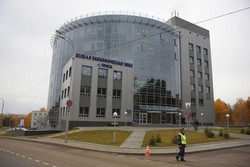 During the First World War, left-wing parties gained even more popularity, and anti-monarchist views were spreading fast. The military and socialist alliance formed by Narym’s Bolsheviks and socialist revolutionaries in political exile moved to Tomsk. The Tsar regime fell in Tomsk without resistance – under a telegram from Petrograd (today’s St. Petersburg). On March 2-3, 1917 the newly created Committee of Public Order and Safety chaired by lawyer Boris Gan gathered under one umbrella all opposition groups – liberals, socialist revolutionaries, Mensheviks, and Bolsheviks. On March 5-6, the Soviet of Soldiers’ Deputies was formed, followed by the Soviet of Workers’ Deputies on March 29. The real power was held by the Military Revolutionary Committee and the 70,000 troops garrison. By the autumn of 1917, the Soviet of Workers’ and Soldiers’ Deputies chaired by Nikolay Yakovlev and the Siberian Oblast Soviet were competing for power.
During the First World War, left-wing parties gained even more popularity, and anti-monarchist views were spreading fast. The military and socialist alliance formed by Narym’s Bolsheviks and socialist revolutionaries in political exile moved to Tomsk. The Tsar regime fell in Tomsk without resistance – under a telegram from Petrograd (today’s St. Petersburg). On March 2-3, 1917 the newly created Committee of Public Order and Safety chaired by lawyer Boris Gan gathered under one umbrella all opposition groups – liberals, socialist revolutionaries, Mensheviks, and Bolsheviks. On March 5-6, the Soviet of Soldiers’ Deputies was formed, followed by the Soviet of Workers’ Deputies on March 29. The real power was held by the Military Revolutionary Committee and the 70,000 troops garrison. By the autumn of 1917, the Soviet of Workers’ and Soldiers’ Deputies chaired by Nikolay Yakovlev and the Siberian Oblast Soviet were competing for power.
In December 1917 – March 1918, the Soviet regime set in. In May 1918, as the revolt of the Czechoslovak Legion broke out in the region, the city was occupied by the forces of the Provisional Siberian Government and then by Kolchak’s army which was facing guerilla resistance in the region. On December 17-18, 1919 in an uprising of Bolshevik, Menshevik, socialist revolutionary and anarchist groups against Kolchak, the city was liberated and the Fifth Red Army entered Tomsk. In early 1920s, armed revolts by Tomsk peasants against the Soviet regime reduced the villages of Tomsk to indigence. Tomsk population shrank to 80,000 people.
Even though industrial production in Tomsk Governorate resumed by 1926, industrialization sidetracked Tomsk. The center of the Soviet Siberia was established in Novonikolayevsk (today’s Novosibirsk), a former downgraded town of Tomsk District. Tomsk had a role of the main supplier of labor and equipment for Siberia’s major coal mining region Kuzbass. The territory of Tomsk Oblast was made one of the main destinations for exile settlers. The resettled population here was around 220,000 people. They worked in mines, forest felling sites, agricultural and industrial artels. Many died of hunger and disease. Some 17,000 Tomsk people, mostly peasants and workers, suffered in Stalin’s repressions. The south of Tomsk Oblast became a place of prison camps and colonies, the largest among them initially Tom-Asinlag and later Voroninlag (1940s-1950s).
History. World War II
During World War II, Tomsk and Kolpashevo received 40 relocated defense industry facilities, dozens of research institutes, educational and cultural organizations, more than 50,000 evacuated people, and 20 hospitals (10,000 beds). Among the relocated facilities were:
Electric bulb factory (it was accommodated in an unfinished building of the Medical Institute and produced its first bulb as early as November 7, 1941)
Cable plant (it fully moved within two months and produced its first kilometer of winding cable in April, 1942)
Bearing manufacturing plant (built in November 1941 in the premises of State Bearing Plant 1 earlier evacuated to Tomsk; until 1992 the facility was called State Bearing Plant 5 and later OAO Roltom)
Sibelectromotor (on August 10, 1941 two first trains with equipment and workers of the Leningrad Elektrosila plant arrived to Tomsk; premises were built at the same time with the installation of the equipment; the first building was completed on November 7; on November 28 the plant started running)
Rubber plant (it was a rubber plant relocated from Moscow; it started running on May 2, 1942; during the war it produced gas masks, rubber parts for tanks, dampers for aircrafts)
Tomsk scientists set up the first in Russia Committee for Industry, Transport, and Agriculture which brought some 300 scientists in various areas in close cooperation with the industry. Over the years of the war, the industrial output of the region increased threefold, and population doubled. 129,000 people from Tomsk went to fight in the war. Out of them 59,000 were killed. Tomsk was the place where many heroic divisions of the Red Army were set up such as the 166th Rifle Division, 366th Rifle (19th Guards) Division, 79th Guards Division, 149th Rifle Brigade, and other units. 42 people from Tomsk became Heroes of the Soviet Union. Artilleryman Afanassy Shilin was awarded the title twice.
History. After the War
Tomsk region proved in the war that it was a self-sufficient economic entity with the 200,000 people city of Tomsk as its capital. Newly established in 1944, Tomsk Oblast is receiving investments for the development of its industry. In 1950s-1960s, there were major reconstructions of the old food producing plants, electromechanical plant, ship-building yards in Samuski and Moryakovka, wood transfer yard, electric bulb factory, pressure gauge plant, cable plant, rubber factory, bearing manufacturing plant, machine-tool plant. New facilities were built such as an electric power plant, a water supply network, facilities producing enameled wire plants, hoisting equipment, instruments (the instrument manufacturing facility was set up in early 60s under a joint resolution by the Central Committee of the Communist Party of the USSR and the Council of Ministers of the Soviet Union; it was a secret facility managed by a war general; it produced space rocket and space vehicle control systems, including the famous Buran shuttle), computing machines (in Soviet times Kontur plant mostly produced numerical control systems and products for the defense industry; today it makes telecommunications, instrumentation, and electrical mechanisms, industrial automation means, mobile and portable automated complexes for various applications), and electronic devices, (this facility was focused on supplying the defense industry and producing consumer goods such as tape recorders Tom’). Those plants and factories formed a basis for the economy of Tomsk Oblast. Forest harvesting operations were mechanized and the construction industry took shape.
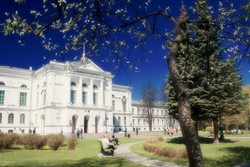 Not far from Tomsk, the world’s largest nuclear facility of the time appears – Siberian Chemical Combine. It included three nuclear stations and five plants. Oil and gas production started to develop. In 1949, the first tram appeared in the streets of Tomsk. There was local aviation and television. Collective farm (‘kolkhoz’) workers moved to cities. The north of the region was deserted. People displaced in the Stalin era were returning to the southern regions. By mid-60s, Tomsk Oblast turned industrial – 56% of its people moved to live in cities. In 1967, by Decree of the Presidium of the Supreme Soviet of the USSR Tomsk Oblast was given the highest award of the Soviet Union – the Order of Lenin – for its accomplishments in economy and culture.
Not far from Tomsk, the world’s largest nuclear facility of the time appears – Siberian Chemical Combine. It included three nuclear stations and five plants. Oil and gas production started to develop. In 1949, the first tram appeared in the streets of Tomsk. There was local aviation and television. Collective farm (‘kolkhoz’) workers moved to cities. The north of the region was deserted. People displaced in the Stalin era were returning to the southern regions. By mid-60s, Tomsk Oblast turned industrial – 56% of its people moved to live in cities. In 1967, by Decree of the Presidium of the Supreme Soviet of the USSR Tomsk Oblast was given the highest award of the Soviet Union – the Order of Lenin – for its accomplishments in economy and culture.
History. Economic boom
The period of Brezhnev Stagnation in Tomsk Oblast was marked by an economic boost driven by the fast track development of the oil sector. In 1954, the first barrel of oil was produced. In 1966, oil output totaled 49,000 tons. In 1976-1980s, the annual output would go up to 8 million tons. In 1980s, it was more than 10 million tons. There are three oil production regions in Tomsk Oblast – Strezhevskoy (near Strezhevoy), Vasyugansky (near village Pionerny), and Pudinsky (near Kedrovy). These oil fields initially supplied the large oil pipeline running from Aleksandrovskoye to Anzhero-Sudzhensk (built in 1972). In 1977, Tomsktransgaz Industrial Association was created to handle associated gas. Since 1978, it has been delivering gas to West Siberian industrial facilities via the Nizhnevartovsk – Parabel – Kuzbass gas pipeline. In 1979, the country’s largest petrochemical refinery was started up in Tomsk. It produced polypropylene, methanol and formaldehyde.
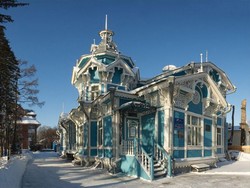 Forest harvesting volumes peaked in the 1970s – 8.5 million cu m. Up to 80% was contributed by Tomlesprom Enterprise (an association of 17 logging enterprises founded in 1936). Agriculture was booming. Tomsk was surrounded by a belt of farming enterprises. Crops and cattle doubled (up to 600,000 tons of grain and up to 60,000 tons of meat annually). Modern industrial facilities appeared such as a reinforced concrete plant, a house building factory, asphalt concrete plants, plants of silica based construction materials, brick factories. The output of reinforced concrete products grew 4 times. Tomsk changed its visage: it had trolleybus lines, a theater, sports and concert halls, new administrative buildings and residential areas. Bridges over the Tom and the Ob were built. A railway line from Asino to Bely Yar appeared. Steam boats on the rivers gave way to motor ships. 170 intercity bus routes were organized. Local aviation as a more expensive way of transport was getting less and less popular.
Forest harvesting volumes peaked in the 1970s – 8.5 million cu m. Up to 80% was contributed by Tomlesprom Enterprise (an association of 17 logging enterprises founded in 1936). Agriculture was booming. Tomsk was surrounded by a belt of farming enterprises. Crops and cattle doubled (up to 600,000 tons of grain and up to 60,000 tons of meat annually). Modern industrial facilities appeared such as a reinforced concrete plant, a house building factory, asphalt concrete plants, plants of silica based construction materials, brick factories. The output of reinforced concrete products grew 4 times. Tomsk changed its visage: it had trolleybus lines, a theater, sports and concert halls, new administrative buildings and residential areas. Bridges over the Tom and the Ob were built. A railway line from Asino to Bely Yar appeared. Steam boats on the rivers gave way to motor ships. 170 intercity bus routes were organized. Local aviation as a more expensive way of transport was getting less and less popular.
In 1978, Tomsk Scientific Center of the Siberian Branch of the Soviet Academy of Sciences (today’s Russian Academy of Sciences) opened. In 1986, Tomsk Scientific Center of the Soviet Academy of Medical Sciences was established. It was the first regional medical science center in the country. There were some 40 industry-specific research and design institutes, a university, five technical schools, and two dozens of specialized secondary schools.
World famous scientists lived and worked in Tomsk Oblast. Among them physicists Nikolay Semyonov (the only Soviet Nobel laureate in chemistry), Vladimir Zuyev (founder and first director of the Institute for Atmospheric Optics of the Siberian Branch of the Soviet Academy of Sciences), Vladimir Kuznetsov (an outstanding expert in solid state physics), Gennady Mesyats (founder of the local high current electronics and electrical pulse physics schools), Aleksander Vorobyov (founder of the local radiation physics and solid state chemistry schools, and rector of the Tomsk Polytechnic Institute in 1944-1970); prominent aircraft designers Nikolay Kamov and Mikhail Mil; architect and designer of the Ostankino Tower Nikolay Nikitin; astronaut Nikolay Rukavishnikov; famous Russian writer, geologist, paleontologist, and geographer Vladimir Obruchev; geologist Mikhail Usov; botanist and founder of the Tomsk systematic botany school Porfiry Krylov.
Famous surgeon Andrey Savinykh was the first surgeon in the world to have successfully removed a food pipe and replaced it with an artificial pipe. This surgery took place on November 2, 1943. The medical journals of the time wrote about it, “They have done what had always been considered to be clinically impossible. It was a global victory of creative mind”. Surgeon Savinykh was among the initiators of the Society for the Spread of Political and Scientific Knowledge and the first chairman of the Tomsk Branch of the Society. There were many other remarkable personalities who lived and worked in Tomsk such as clinician Dmitry Yablokov, historian Aleksander Danilov, etc. Tomsk strengthened its positions of the most important and influential educational and scientific center in the east of the country. It enjoyed authority across all Western Siberia and a significant part of Kazakhstan. The region owes many of its accomplishments of the time to its leadership, namely First Secretary of the CPSU Oblast Committee Egor Ligachyov who governed Tomsk Oblast for 17 years.
History. Post-Soviet era
Along with the collapse of the Soviet Union, the efficiency of the region’s economy was going down. Fixed capital assets almost doubled – from 3.9 billion rubles in 1986 to 7.4 billion rubles in 1991 – but industrial output went up only 22%. Return on assets reduced by almost 20%. Unsuccessful reforms by Mikhail Gorbachev first impaired the industrial and construction sectors – they showed worse performance in 1991 – and then agriculture which started going down on performance in 1993.
After the collapse of the CPSU and the Soviet Union, Tomsk leadership changed. In October 1991, Viktor Kress was appointed head of the administration of Tomsk Oblast. He was four times re-elected Governor of Tomsk Oblast. His total term of the governor’s office was more than 20 years. On March 27, 1994 first elections to the new legislative body of the region – Tomsk Oblast Duma – took place. Boris Maltsev became the first Duma Speaker. He was re-elected Speaker of the Duma of four convocations in a row. The Duma deputies had to start legislative work almost from scratch. There was only a very feeble regulatory framework. They had to develop and adopt all fundamental laws which define the governance system of the region such as the Charter of Tomsk Oblast, laws on governor’s and mayor’s elections, laws on elections to the Duma, and laws to support readjustments in the economy and the social development of the region in the changed conditions.
Tomsk Oblast rather successfully got over the market reforms and political turmoil of the post-Soviet times. The food industry, utility enterprises, the power sector stood the test of time having successfully passed corporatization and privatization. At the same time, many defense industry enterprises turned out to be uncompetitive.
Modern times. Economy
In 2002, annual oil production in the region totaled 10.2 million tons and beat the 1989 record. In 2005, oil and condensate production totaled 13.6 million tons. OAO Tomskneft was the largest producer. Since 1995, Tomsk Oblast has been developing gas production. The largest gas producer in the region - OAO Vostokgazprom - is Gazprom's subsidiary. OAO Vostokgazprom was set up in 1999 and pioneered natural gas production in the region. After only one year of operations, Vostokgazprom was paying to the regional budget 5% of all taxes. Meanwhile, a social program for gas industry workers was launched in the region - building and rebuilding of social facilities in remote settlements in the taiga regions, setting up of the "Polyclinic Boat" initiative, various programs to promote physical culture and sports. In 2005, annual gas production totaled 4.5 billion cu m. Gas is supplied to the Tomsk Petrochemical Refinery, to household consumers in Western Siberia, and to China.
The region's industry is shaped by some 200 large and
Tomsk Oblast has always been leading among Russian and Siberian regions for small business development rates. Since 2004, Tomsk Oblast has six times won in the contest "Best results in small and medium business development".
Agriculture has been recovering after the
The largest farming enterprises are Siberian Agrarian Group, Mezheninovskaya and Tomskaya Poultry Farms, and Tomsk Food Company. The largest dairy producers are breed livestock farms Dubrovskoye, Zavarzino, and Nelyubino.
Tomsk Oblast is the first in Siberia and eighth in Russia for the productivity of dairy livestock. It is in top ten Russian regions for meat production volumes. Almost 50% of the total annual output of meat and milk is produced by private farmers. Tomsk berries and vegetables are exported to many countries.
The economic boom started in 1999, was followed by a slowdown in 2008–2014. Development through extensive utilization of natural resources is becoming ineffective. Stakes are shifting today to the intellectual potential of Tomsk and Seversk.
Over the last few years, the GRP share of
Since 2002, the region has been implementing the Regional Strategy of Innovative Development, and actively supporting the investment activity. Tomsk Oblast has built a very
The region has created a firm innovative infrastructure which supports commercialization of inventions. It has a special economic zone of technical innovation type in the city of Tomsk, 13 commercialization offices for innovative ideas by universities and academic institutes, 8 business incubators, 1 center for technology and innovations, 6 venture partners of the Seed Fund of the Russian Venture Company, a business angels network, the Technology Transfer Center,
There are 435 schools, 10,500 school teachers, more than 100,000 school students. Around 85,000 students (per 500,000 Tomsk citizens) study full and part time in the universities of Tomsk Oblast, as well as in 12 branches and representative offices from other cities. Annually, almost 15,700 specialists graduate from Tomsk universities and institutes. Many specialize in the Special Economic Zone areas of activity. There are 6 universities, 17 other institutions of higher education, 23 academics and corresponding members of national academies, more than 700 doctors of science, more than 4,000 PhDs, 1,500
Tomsk State University became a model of a research university, Tomsk Polytechnic University - a model of an innovative academic university, Tomsk University of Control Systems and Radio Electronics (TUSUR) - a model of a business university. Tomsk State University and TUSUR were among 17 winners of the national contest of innovation programs by Russian universities. More than 60 companies are involved in the research activity. More than 270 companies develop innovations. In 2005, Tomsk Oblast won in the contest for the right to host a special economic zone of technical innovation type. The SEZ develops ICT, electronics, new materials and nanotechnology, biotechnology and medical technologies. Over 10,000 new jobs will have been created by 2015. The first SEZ site in Tomsk was created on the basis of Tomskneftekhim assets in 2006.
For 15 years in a row, Tomsk has been holding the forum for innovations INNOVUS. In 1998, the Administration of Tomsk Oblast supported the idea to sponsor a forum which would include an exhibition of innovative products, a conference, seminars, and a contact exchange. The forum started as a
On October 6, 2011 the concept of the INOTomsk’2020 project was approved by the Government of the Russian Federation. The project involves setting up a world class center for education, research, and development in Tomsk by 2020.
Culture, sports, healthcare
Tomsk is one of the cultural centers of Siberia. In the 19th and early 20th centuries, among famous people who lived and worked here were poet Petr Dravert; writers Nikolay Naumov, Vyacheslav Shishkov, Valentin Kuritsyn (
Tomsk Oblast has
Tomsk Oblast has more than 500 healthcare facilities, 18,000 doctors and medical workers. In per capita terms, it is 1.5 times more than the national average, largely because Tomsk has its own medical university - Siberian State Medical University - which is a successor to the Tomsk Emperor's University. Spa resort Chazhemto is known far beyond Tomsk Oblast.
Tomsk Oblast today

 In 2011–2012, Tomsk Oblast changed leadership. The Legislative Duma of Tomsk Oblast of the 5th convocation elected Oksana Kozlovskaya the Speaker and conferred governor powers to the new Governor of Tomsk Oblast. On March 17, 2012 a ceremonial session of the Legislative Duma of Tomsk Oblast took place where the stepping out governor Viktor Kress ceded his office to Sergey Zhvachkin.
In 2011–2012, Tomsk Oblast changed leadership. The Legislative Duma of Tomsk Oblast of the 5th convocation elected Oksana Kozlovskaya the Speaker and conferred governor powers to the new Governor of Tomsk Oblast. On March 17, 2012 a ceremonial session of the Legislative Duma of Tomsk Oblast took place where the stepping out governor Viktor Kress ceded his office to Sergey Zhvachkin.
New leaders have continued on the path taken by their predecessors and pursued on the region’s development goals defined in the Tomsk Oblast Development Strategy approved by the Legislative Duma of Tomsk Oblast in 2005 and updated in 2012, "High wellbeing rates and living standards through a dynamic, well developed and balanced competitive economy securing high income and making Tomsk Oblast the best place to live and work."
© The State Duma of the Tomsk oblast, 2007-2025
